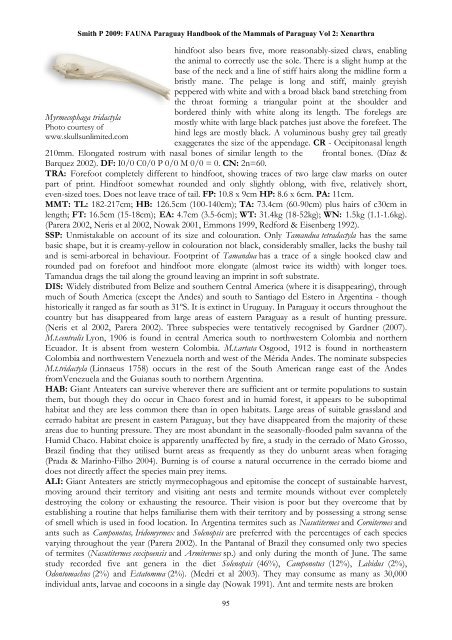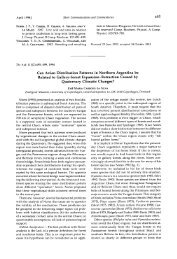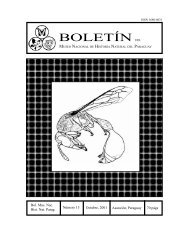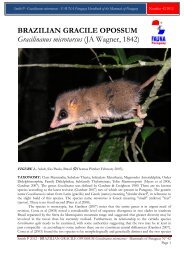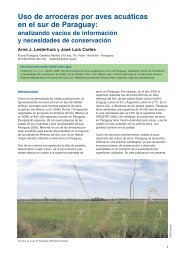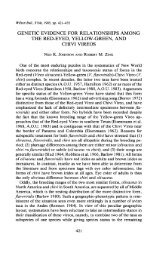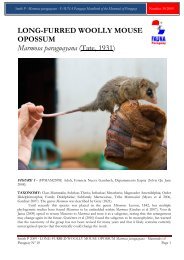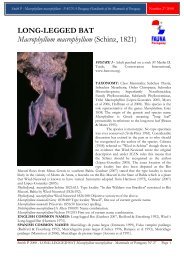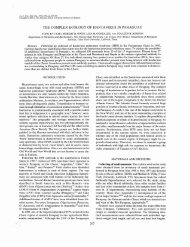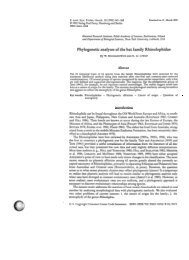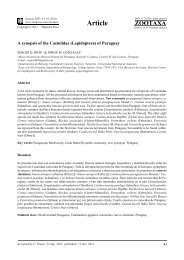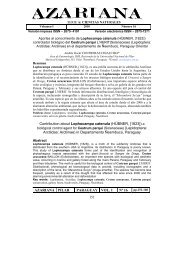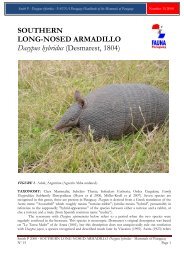hbk mammals vol 2 - FAUNA Paraguay
hbk mammals vol 2 - FAUNA Paraguay
hbk mammals vol 2 - FAUNA Paraguay
You also want an ePaper? Increase the reach of your titles
YUMPU automatically turns print PDFs into web optimized ePapers that Google loves.
Smith P 2009: <strong>FAUNA</strong> <strong>Paraguay</strong> Handbook of the Mammals of <strong>Paraguay</strong> Vol 2: Xenarthra<br />
Myrmecophaga tridactyla<br />
Photo courtesy of<br />
www.skullsunlimited.com<br />
hindfoot also bears five, more reasonably-sized claws, enabling<br />
the animal to correctly use the sole. There is a slight hump at the<br />
base of the neck and a line of stiff hairs along the midline form a<br />
bristly mane. The pelage is long and stiff, mainly greyish<br />
peppered with white and with a broad black band stretching from<br />
the throat forming a triangular point at the shoulder and<br />
bordered thinly with white along its length. The forelegs are<br />
mostly white with large black patches just above the forefeet. The<br />
hind legs are mostly black. A <strong>vol</strong>uminous bushy grey tail greatly<br />
exaggerates the size of the appendage. CR - Occipitonasal length<br />
210mm. Elongated rostrum with nasal bones of similar length to the frontal bones. (Díaz &<br />
Barquez 2002). DF: I0/0 C0/0 P 0/0 M 0/0 = 0. CN: 2n=60.<br />
TRA: Forefoot completely different to hindfoot, showing traces of two large claw marks on outer<br />
part of print. Hindfoot somewhat rounded and only slightly oblong, with five, relatively short,<br />
even-sized toes. Does not leave trace of tail. FP: 10.8 x 9cm HP: 8.6 x 6cm. PA: 11cm.<br />
MMT: TL: 182-217cm; HB: 126.5cm (100-140cm); TA: 73.4cm (60-90cm) plus hairs of c30cm in<br />
length; FT: 16.5cm (15-18cm); EA: 4.7cm (3.5-6cm); WT: 31.4kg (18-52kg); WN: 1.5kg (1.1-1.6kg).<br />
(Parera 2002, Neris et al 2002, Nowak 2001, Emmons 1999, Redford & Eisenberg 1992).<br />
SSP: Unmistakable on account of its size and colouration. Only Tamandua tetradactyla has the same<br />
basic shape, but it is creamy-yellow in colouration not black, considerably smaller, lacks the bushy tail<br />
and is semi-arboreal in behaviour. Footprint of Tamandua has a trace of a single hooked claw and<br />
rounded pad on forefoot and hindfoot more elongate (almost twice its width) with longer toes.<br />
Tamandua drags the tail along the ground leaving an imprint in soft substrate.<br />
DIS: Widely distributed from Belize and southern Central America (where it is disappearing), through<br />
much of South America (except the Andes) and south to Santiago del Estero in Argentina - though<br />
historically it ranged as far south as 31ºS. It is extinct in Uruguay. In <strong>Paraguay</strong> it occurs throughout the<br />
country but has disappeared from large areas of eastern <strong>Paraguay</strong> as a result of hunting pressure.<br />
(Neris et al 2002, Parera 2002). Three subspecies were tentatively recognised by Gardner (2007).<br />
M.t.centralis Lyon, 1906 is found in central America south to northwestern Colombia and northern<br />
Ecuador. It is absent from western Colombia. M.t.artata Osgood, 1912 is found in northeastern<br />
Colombia and northwestern Venezuela north and west of the Mérida Andes. The nominate subspecies<br />
M.t.tridactyla (Linnaeus 1758) occurs in the rest of the South American range east of the Andes<br />
fromVenezuela and the Guianas south to northern Argentina.<br />
HAB: Giant Anteaters can survive wherever there are sufficient ant or termite populations to sustain<br />
them, but though they do occur in Chaco forest and in humid forest, it appears to be suboptimal<br />
habitat and they are less common there than in open habitats. Large areas of suitable grassland and<br />
cerrado habitat are present in eastern <strong>Paraguay</strong>, but they have disappeared from the majority of these<br />
areas due to hunting pressure. They are most abundant in the seasonally-flooded palm savanna of the<br />
Humid Chaco. Habitat choice is apparently unaffected by fire, a study in the cerrado of Mato Grosso,<br />
Brazil finding that they utilised burnt areas as frequently as they do unburnt areas when foraging<br />
(Prada & Marinho-Filho 2004). Burning is of course a natural occurrence in the cerrado biome and<br />
does not directly affect the species main prey items.<br />
ALI: Giant Anteaters are strictly myrmecophagous and epitomise the concept of sustainable harvest,<br />
moving around their territory and visiting ant nests and termite mounds without ever completely<br />
destroying the colony or exhausting the resource. Their vision is poor but they overcome that by<br />
establishing a routine that helps familiarise them with their territory and by possessing a strong sense<br />
of smell which is used in food location. In Argentina termites such as Nasutitermes and Cornitermes and<br />
ants such as Camponotus, Iridomyrmex and Solenopsis are preferred with the percentages of each species<br />
varying throughout the year (Parera 2002). In the Pantanal of Brazil they consumed only two species<br />
of termites (Nasutitermes coxipoensis and Armitermes sp.) and only during the month of June. The same<br />
study recorded five ant genera in the diet Solenopsis (46%), Camponotus (12%), Labidus (2%),<br />
Odontomachus (2%) and Ectatomma (2%). (Medri et al 2003). They may consume as many as 30,000<br />
individual ants, larvae and cocoons in a single day (Nowak 1991). Ant and termite nests are broken<br />
95


